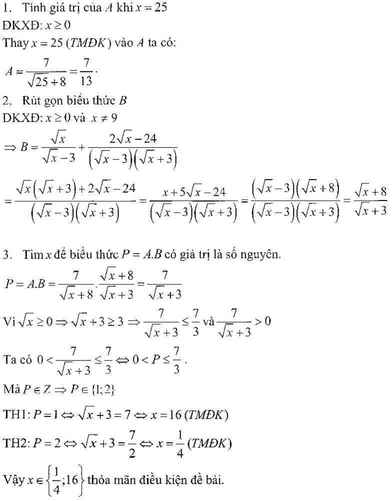Tìm x nguyên sao cho biểu thức \(\dfrac{x+1}{x^2+2022}\) là số nguyên
Hãy nhập câu hỏi của bạn vào đây, nếu là tài khoản VIP, bạn sẽ được ưu tiên trả lời.


a: ĐKXĐ: \(\left\{{}\begin{matrix}x>=0\\x\notin\left\{4;1\right\}\end{matrix}\right.\)
Ta có: \(A=\dfrac{x-4\sqrt{x}+3-\left(2x-4\sqrt{x}-\sqrt{x}+2\right)+x+2}{\left(\sqrt{x}-2\right)\left(\sqrt{x}-1\right)}\)
\(=\dfrac{2x-4\sqrt{x}+5-2x+5\sqrt{x}-2}{\left(\sqrt{x}-2\right)\left(\sqrt{x}-1\right)}\)
\(=\dfrac{\sqrt{x}+3}{\left(\sqrt{x}-2\right)\left(\sqrt{x}-1\right)}\)

a: ĐKXĐ: \(\left\{{}\begin{matrix}x>=0\\x\notin\left\{1;4\right\}\end{matrix}\right.\)
\(A=\dfrac{\sqrt{x}-3}{\sqrt{x}-2}-\dfrac{2\sqrt{x}-1}{\sqrt{x}-1}+\dfrac{x-2}{x-3\sqrt{x}+2}\)
\(=\dfrac{\sqrt{x}-3}{\sqrt{x}-2}-\dfrac{2\sqrt{x}-1}{\sqrt{x}-1}+\dfrac{x-2}{\left(\sqrt{x}-2\right)\left(\sqrt{x}-1\right)}\)
\(=\dfrac{\left(\sqrt{x}-3\right)\left(\sqrt{x}-1\right)-\left(2\sqrt{x}-1\right)\left(\sqrt{x}-2\right)+x-2}{\left(\sqrt{x}-2\right)\left(\sqrt{x}-1\right)}\)
\(=\dfrac{x-4\sqrt{x}+3-2x+5\sqrt{x}-2+x-2}{\left(\sqrt{x}-2\right)\left(\sqrt{x}-1\right)}\)
\(=\dfrac{\sqrt{x}-1}{\left(\sqrt{x}-2\right)\left(\sqrt{x}-1\right)}=\dfrac{1}{\sqrt{x}-2}\)
b: Để A>2 thì A-2>0
=>\(\dfrac{1-2\left(\sqrt{x}-2\right)}{\sqrt{x}-2}>0\)
=>\(\dfrac{5-2\sqrt{x}}{\sqrt{x}-2}>0\)
=>\(\dfrac{2\sqrt{x}-5}{\sqrt{x}-2}< 0\)
TH1: \(\left\{{}\begin{matrix}2\sqrt{x}-5>0\\\sqrt{x}-2< 0\end{matrix}\right.\)
=>\(\left\{{}\begin{matrix}\sqrt{x}>\dfrac{5}{2}\\\sqrt{x}< 2\end{matrix}\right.\)
=>\(x\in\varnothing\)
TH2: \(\left\{{}\begin{matrix}2\sqrt{x}-5< 0\\\sqrt{x}-2>0\end{matrix}\right.\)
=>\(\left\{{}\begin{matrix}\sqrt{x}< \dfrac{5}{2}\\\sqrt{x}>2\end{matrix}\right.\)
=>\(2< \sqrt{x}< \dfrac{5}{2}\)
=>4<x<25/4
c: Để A là số nguyên thì \(1⋮\sqrt{x}-2\)
=>\(\sqrt{x}-2\in\left\{1;-1\right\}\)
=>\(\sqrt{x}\in\left\{3;1\right\}\)
=>\(x\in\left\{1;9\right\}\)
kết hợp ĐKXĐ, ta được: x=9

1: Ta có: \(A=\left(\dfrac{\sqrt{x}+2}{x+2\sqrt{x}+1}-\dfrac{\sqrt{x}-2}{x-1}\right):\dfrac{\sqrt{x}}{\sqrt{x}+1}\)
\(=\left(\dfrac{\left(\sqrt{x}+2\right)\left(\sqrt{x}-1\right)}{\left(\sqrt{x}-1\right)\left(\sqrt{x}+1\right)^2}-\dfrac{\left(\sqrt{x}-2\right)\left(\sqrt{x}+1\right)}{\left(\sqrt{x}-1\right)\left(\sqrt{x}+1\right)^2}\right):\dfrac{\sqrt{x}}{\sqrt{x}+1}\)
\(=\dfrac{x-\sqrt{x}+2\sqrt{x}-2-\left(x+\sqrt{x}-2\sqrt{x}-2\right)}{\left(\sqrt{x}-1\right)\left(\sqrt{x}+1\right)^2}:\dfrac{\sqrt{x}}{\sqrt{x}+1}\)
\(=\dfrac{x+\sqrt{x}-2-x+\sqrt{x}+2}{\left(\sqrt{x}-1\right)\left(\sqrt{x}+1\right)^2}\cdot\dfrac{\sqrt{x}+1}{\sqrt{x}}\)
\(=\dfrac{2\sqrt{x}}{\sqrt{x}\left(x-1\right)}\)
\(=\dfrac{2}{x-1}\)
2: ĐKXĐ: \(\left\{{}\begin{matrix}x>0\\x\ne1\end{matrix}\right.\)
Để A là số nguyên thì \(2⋮x-1\)
\(\Leftrightarrow x-1\inƯ\left(2\right)\)
\(\Leftrightarrow x-1\in\left\{1;-1;2;-2\right\}\)
\(\Leftrightarrow x\in\left\{2;0;3;-1\right\}\)
Kết hợp ĐKXĐ, ta được: \(x\in\left\{2;3\right\}\)
Vậy: Để A là số nguyên thì \(x\in\left\{2;3\right\}\)

A = \(\dfrac{2x-1}{x+2}\)
a, A là phân số ⇔ \(x\) + 2 # 0 ⇒ \(x\) # -2
b, Để A là một số nguyên thì 2\(x-1\) ⋮ \(x\) + 2
⇒ 2\(x\) + 4 - 5 ⋮ \(x\) + 2
⇒ 2(\(x\) + 2) - 5 ⋮ \(x\) + 2
⇒ 5 ⋮ \(x\) + 2
⇒ \(x\) + 2 \(\in\) { -5; -1; 1; 5}
⇒ \(x\) \(\in\) { -7; -3; -1; 3}
c, A = \(\dfrac{2x-1}{x+2}\)
A = 2 - \(\dfrac{5}{x+2}\)
Với \(x\) \(\in\) Z và \(x\) < -3 ta có
\(x\) + 2 < - 3 + 2 = -1
⇒ \(\dfrac{5}{x+2}\) > \(\dfrac{5}{-1}\) = -5 ⇒ - \(\dfrac{5}{x+2}\)< 5
⇒ 2 - \(\dfrac{5}{x+2}\) < 2 + 5 = 7 ⇒ A < 7 (1)
Với \(x\) > -3; \(x\) # - 2; \(x\in\) Z ⇒ \(x\) ≥ -1 ⇒ \(x\) + 2 ≥ -1 + 2 = 1
\(\dfrac{5}{x+2}\) > 0 ⇒ - \(\dfrac{5}{x+2}\) < 0 ⇒ 2 - \(\dfrac{5}{x+2}\) < 2 (2)
Với \(x=-3\) ⇒ A = 2 - \(\dfrac{5}{-3+2}\) = 7 (3)
Kết hợp (1); (2) và(3) ta có A(max) = 7 ⇔ \(x\) = -3

Bài 5:
\(C=\frac{2\sqrt{x}-3}{\sqrt{x}-2}=\frac{2(\sqrt{x}-2)+1}{\sqrt{x}-2}=2+\frac{1}{\sqrt{x}-2}\)
Để $C$ nguyên nhỏ nhất thì $\frac{1}{\sqrt{x}-2}$ là số nguyên nhỏ nhất.
$\Rightarrow \sqrt{x}-2$ là ước nguyên âm lớn nhất
$\Rightarrow \sqrt{x}-2=-1$
$\Leftrightarrow x=1$ (thỏa mãn đkxđ)
Bài 6:
$D(\sqrt{x}+1)=x-3$
$D^2(x+2\sqrt{x}+1)=(x-3)^2$
$2D^2\sqrt{x}=(x-3)^2-D^2(x+1)$ nguyên
Với $x$ nguyên ta suy ra $\Rightarrow D=0$ hoặc $\sqrt{x}$ nguyên
Với $D=0\Leftrightarrow x=3$ (tm)
Với $\sqrt{x}$ nguyên:
$D=\frac{(x-1)-2}{\sqrt{x}+1}=\sqrt{x}-1-\frac{2}{\sqrt{x}+1}$
$D$ nguyên khi $\sqrt{x}+1$ là ước của $2$
$\Rightarrow \sqrt{x}+1\in\left\{1;2\right\}$
$\Leftrightarrow x=0; 1$
Vì $x\neq 1$ nên $x=0$.
Vậy $x=0; 3$

a) 2ˣ + 2ˣ⁺³ = 72
2ˣ.(1 + 2³) = 72
2ˣ.9 = 72
2ˣ = 72 : 9
2ˣ = 8
2ˣ = 2³
x = 3
b) Để số đã cho là số nguyên thì (x - 2) ⋮ (x + 1)
Ta có:
x - 2 = x + 1 - 3
Để (x - 2) ⋮ (x + 1) thì 3 ⋮ (x + 1)
⇒ x + 1 ∈ Ư(3) = {-3; -1; 1; 3}
⇒ x ∈ {-4; -2; 0; 2}
Vậy x ∈ {-4; -2; 0; 2} thì số đã cho là số nguyên
c) P = |2x + 7| + 2/5
Ta có:
|2x + 7| ≥ 0 với mọi x ∈ R
|2x + 7| + 2/5 ≥ 2/5 với mọi x ∈ R
Vậy GTNN của P là 2/5 khi x = -7/2

1) Ta có: \(P=\dfrac{1}{\sqrt{x}-1}-\dfrac{x\sqrt{x}-\sqrt{x}}{x+1}\left(\dfrac{1}{x-2\sqrt{x}+1}+\dfrac{1}{1-x}\right)\)
\(=\dfrac{1}{\sqrt{x}-1}-\dfrac{\sqrt{x}\left(x-1\right)}{x+1}\cdot\left(\dfrac{\sqrt{x}+1-\left(\sqrt{x}-1\right)}{\left(\sqrt{x}-1\right)^2\cdot\left(\sqrt{x}+1\right)}\right)\)
\(=\dfrac{1}{\sqrt{x}-1}-\dfrac{\sqrt{x}\left(\sqrt{x}-1\right)\left(\sqrt{x}+1\right)}{x+1}\cdot\dfrac{2}{\left(\sqrt{x}-1\right)^2\cdot\left(\sqrt{x}+1\right)}\)
\(=\dfrac{1}{\sqrt{x}-1}-\dfrac{2\sqrt{x}}{\left(x+1\right)\left(\sqrt{x}-1\right)}\)
\(=\dfrac{x-2\sqrt{x}+1}{\left(x+1\right)\left(\sqrt{x}-1\right)}\)
\(=\dfrac{\sqrt{x}-1}{x+1}\)
Để \(P=-\dfrac{2}{5}\) thì \(\dfrac{\sqrt{x}-1}{x+1}=\dfrac{-2}{5}\)
\(\Leftrightarrow-2x-2=5\sqrt{x}-5\)
\(\Leftrightarrow-2x-2-5\sqrt{x}+5=0\)
\(\Leftrightarrow-2x-5\sqrt{x}+3=0\)
\(\Leftrightarrow-2x-6\sqrt{x}+\sqrt{x}+3=0\)
\(\Leftrightarrow-2\sqrt{x}\left(\sqrt{x}+3\right)+\left(\sqrt{x}+3\right)=0\)
\(\Leftrightarrow\left(\sqrt{x}+3\right)\left(-2\sqrt{x}+1\right)=0\)
\(\Leftrightarrow-2\sqrt{x}+1=0\)
\(\Leftrightarrow-2\sqrt{x}=-1\)
\(\Leftrightarrow x=\dfrac{1}{4}\)(thỏa ĐK)

1: Ta có: \(A=\left(\dfrac{x^2-16}{x-4}-1\right):\left(\dfrac{x-2}{x-3}+\dfrac{x+3}{x+1}+\dfrac{x+2-x^2}{x^2-2x-3}\right)\)
\(=\left(x+4-1\right):\left(\dfrac{\left(x-2\right)\left(x+1\right)}{\left(x-3\right)\left(x+1\right)}+\dfrac{\left(x+3\right)\left(x-3\right)}{\left(x+1\right)\left(x-3\right)}+\dfrac{-x^2+x+2}{\left(x-3\right)\left(x+1\right)}\right)\)
\(=\left(x+3\right):\dfrac{x^2+x-2x-2+x^2-9-x^2+x+2}{\left(x-3\right)\left(x+1\right)}\)
\(=\left(x+3\right):\dfrac{x^2-9}{\left(x-3\right)\left(x+1\right)}\)
\(=\dfrac{\left(x+3\right)\left(x-3\right)\left(x+1\right)}{x^2-9}\)
\(=x+1\)
ĐKXĐ: \(x\notin\left\{4;3;-1\right\}\)
2: Để \(\dfrac{A}{x^2+x+1}\) nhận giá trị nguyên thì \(x+1⋮x^2+x+1\)
\(\Leftrightarrow x^2+x⋮x^2+x+1\)
\(\Leftrightarrow x^2+x+1-1⋮x^2+x+1\)
mà \(x^2+x+1⋮x^2+x+1\)
nên \(-1⋮x^2+x+1\)
\(\Leftrightarrow x^2+x+1\inƯ\left(-1\right)\)
\(\Leftrightarrow x^2+x+1\in\left\{1;-1\right\}\)
\(\Leftrightarrow x^2+x\in\left\{0;-2\right\}\)
\(\Leftrightarrow x^2+x=0\)(Vì \(x^2+x>-2\forall x\))
\(\Leftrightarrow x\left(x+1\right)=0\)
\(\Leftrightarrow\left[{}\begin{matrix}x=0\\x+1=0\end{matrix}\right.\Leftrightarrow\left[{}\begin{matrix}x=0\left(nhận\right)\\x=-1\left(loại\right)\end{matrix}\right.\)
Vậy: Để \(\dfrac{A}{x^2+x+1}\) nhận giá trị nguyên thì x=0

\(\dfrac{x+1}{x^2+2022}\) là số nguyên thì:
\(\left(x+1\right)⋮\left(x^2+2022\right)\\ \Rightarrow\left[\left(x+1\right)\left(x-1\right)\right]⋮\left(x^2+2022\right)\\ \Rightarrow\left(x^2+x-x-1\right)⋮\left(x^2+2022\right)\\ \Rightarrow\left(x^2-1\right)⋮\left(x^2+2022\right)\\ \Rightarrow\left(x^2+2022-2023\right)⋮\left(x^2+2022\right)\)
\(Mà.\left(x^2+2022\right)⋮\left(x^2+2022\right)\\ \Rightarrow2023⋮\left(x^2+2022\right)\\ \Rightarrow x^2+2022\inƯ\left(2023\right)\\ \Rightarrow x^2+2022\in\left\{-289;-119;-17;-7;-1;-2023;1;7;17;119;289;2023\right\}\)
Ta có: \(x^2+2022\ge0\Rightarrow x^2+2022=2023\Rightarrow x^2=1\Rightarrow x=\pm1\)
Vậy \(x=\pm1\) thì biểu thức trên là số nguyên
=)) của shop t edit nên ko cs link